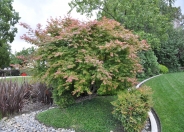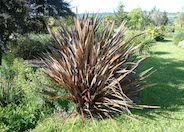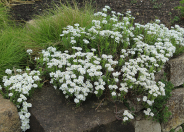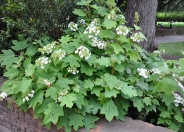
Common name: Japanese Maple
Botanical name: Acer palmatum
This magnificient plant can used as a small tree or shrub. It is deciduous with graceful leaves which have a scarlet color in spring as it leafs out. Leaves later turn orange or yellow in fall. It is slow growing to 20', and requires shelter from the hot sun. The leaves of this tree are small, light green in color, and deeply lobed. It should also be noted that this tree remains spectacular throughout all seasons.

Common name: New Zealand Flax, Purple
Botanical name: Phormium tenax 'Atropurpureum'
Phormium tenax 'Atropurpureum' is an evergreen perennial. Big, dramatic plant composed of many swordlike, stiffly vertical leaves can reach 5' tall. Leaves are purple red. Flowers stems reach high above leaves, bearing clusters of 1"-2" blossoms in dark red.

Common name: Evergreen Candytuft
Botanical name: Iberis sempervirens
This Evergreen Candytuft is a compact plant that grows 12" tall and 18" wide. Its leaves are dark green, leathery and narrow. In the early spring, it exhibits clusters of pure white flowers that are borne at branch ends. This lovely perennial will have more blooms if planted in full sun but will tolerate part shade. It does best in well draining soil. Mature plants can become drought tolerant. Mulch plant well if located in cold winter climates. Plant does poorly if soil is constantly wet. May be prone to mold and mildew, slugs and snails. Looks great in containers and with rocks.

Common name: Oakleaf Hydrangea
Botanical name: Hydrangea quercifolia
This fast-growing, dense, rounded deciduous shrub reaches 4-6' tall and wide. Broad, large, lobed, dark green leaves are light underneath; leaves resemble oak leaf shape, thus its common name. During spring and summer, long panicles white flowers appear on exfoliating branches. Because it blooms on its old wood, the plant should not be pruned until after flowering. Its leaves turn a dark bronzy purple during the fall. The plant should receive sun to part shade and planted in moist, fertile, well draining soil. It does not tolerate frost and does best in an area protected from wind and fierce sun. May need extra summer water; mulch plant well. This shrub suckers; prune after flowering season. A beautiful plant when planted in mass for shrub borders in a woodland garden style.